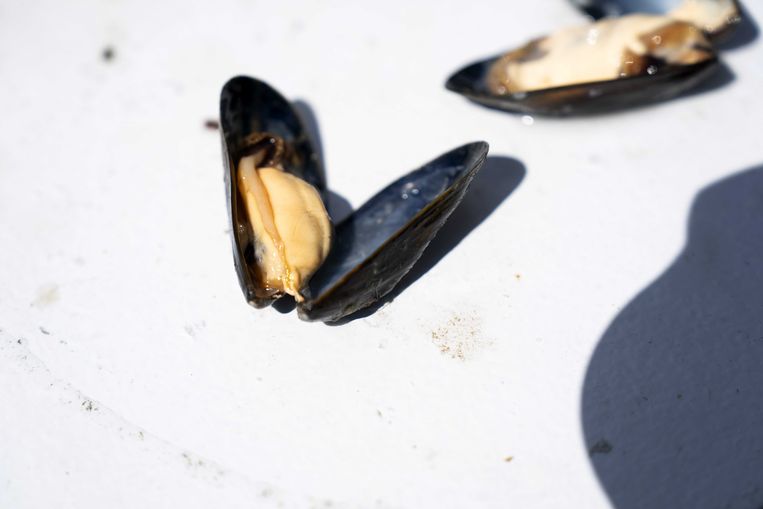Mussel season has finally opened and supermarkets are vying to offer them at the lowest price. However, it is about 5 percent more expensive this year. How did this happen? Where can you find the cheapest? Caroline Verwijs of mussel processor Krijn Verwijs explains and shares tips for scoring cheaper samples.
Say summer in Belgium and say mussels and fries. Shells are so popular in our country that the official start of the season is one of the headlines in the news every year. However, there is a slight joy factor this year: Mussels aren’t escaping from the more expensive life. According to Delhaize, it will be 5 percent more expensive than last year.
To find out why mussel prices have soared this year, Yerseke is the perfect place to look for answers. In this Dutch municipality, almost all mussels pass into Belgium. When you drive into this village across the dam, you’ll see it right away: dozens of large mussel and oyster processing factories looming out of nowhere. Oosterschelde undulates at the back, inlet of the North Sea, and is the perfect place to grow mussels.
From mussels in the sea to mussels on your plate
“There are many steps between mussels caught from the sea and mussels that end up on your plate,” explains Caroline Verwijs of Krijn Verwijs, one of the mussel processing plants in Yerseke. “Farmers and sellers have to work closely together to get the shells to the stores on time. It doesn’t always happen without hitches, because everyone naturally wants to get the best price. Yet they can’t live without each other. A farmer can’t take his boat to store and we can’t get there with empty trays.”
Meanwhile, the mussel boat is sailing back towards the sea. “For example, this farmer just came in to sell his mussels,” Verwes says. “It is now noon, so tomorrow the mussels will be packed and then headed straight to the supermarkets. All the mussels are caught at the refrigeration counter within 48 hours. This speed is crucial. After all, mussels don’t last forever and supermarkets usually require Mark has a validity period of one week. So all links in the chain must be able to operate very quickly.”
More certainty about mussels, higher prices
At the beginning of the story behind the (rising) price of mussels is a mussel farmer, an artisan that is surprisingly comparable to a farmer who grows grain, for example. Like him, a mussel farmer manages specific “fields” in the sea and has to grow mussels every year. However, a mussel farmer cannot simply buy his own seed. For that he needs a nudge from nature.
During the breeding season, mussels secrete a kind of milky water into the sea, which contains millions of eggs and sperm. The fertilized eggs develop into swimming larvae which in turn – if not eaten by fish or crabs – become tiny shells. They grow larger and sink to the bottom due to their increased weight, as the mussel’s seed sticks to their beards.
Mussel farmers used to catch those seeds in the wild and spread them in their own fields, but today more and more mussel farmers work with so-called mussel seed capture facilities. These are large ropes with many branches in the sea and to which small mussels can stick. As a result, mussel farmers can give certain parts of the sea more peace and are more certain about the supply of mussel fry, but this means significant additional costs.
Is the price of mussels from soil and suspension culture significantly different?
Mussel farmers have two options for sowing: traditional soil culture or the newer suspension culture. for soil culture He plants a mussel seed in a field in a quiet part of the sea and then lets nature do its work. After a while, the fisherman “grows” young mussels, or raises them again and transplants them to another plot of land. After all, larger and heavier mussels cannot be washed so easily, and therefore do not need to be protected. There they continue to grow until they are ready to be consumed. For the most common mussel shapes, which are jumbo 6 to 7 centimeters, this process takes two years.
If a mussel man is working in a hang culture system, he fills special watertight bags with mussel seeds, and suspends them in the sea with buoys and anchors until they are ready to be consumed. This is a bit faster than bottom farming, because mussels catch more sunlight on the high seas. The shell is more fragile than in bottom-farmed mussels, but otherwise they cannot be separated.
Whichever scenario the mussel farmer chooses: with both of them you immediately feel that a lot of manpower, investment and time are needed to get started. “And then every farmer has to deal with different challenges,” says Caroline Verwijs. Last year, for example, some violent storms wiped out entire crops. Maintaining their ship and other equipment costs a lot of money. Like any other business, mussel fishers are also suffering from rising fuel prices and rising wage costs.”
Where does the large additional cost come from?
After harvesting, the mussel farmer deposits his catch in a processing plant like Caroline Ferrois’s. “This, too, can only work with so much energy, with machines, and with so much people,” she says. What exactly is going on there? First of all, a thorough cleaning is on the agenda. After all, mussels get their food from sea water, which means that freshly caught shells always contain sand. Prefer not to put it in your mouth while eating. In a large irrigation facility with containers filled with continually filtered seawater, mussels rinse themselves clean within six to eight hours.”
Then the machine picks up stones and crabs from among the shells. The next machine removes beards. Then thousands of kilograms of mussels pass again through the watchful eyes of a few sorting workers in green aprons and waterproof gloves. They remove broken or opened shells by hand, or select clams from among them. They keep it in a separate jar and divide it among themselves at the end of their shift.
Mussels are a natural product and appear on the surface in all sizes. Our mussel pots only come in one size, which is often a common size. This sorting process is also a manual work, which entails costs. Then the cooled mussels are transferred to the packaging department, where people also take care of them. The list of (personnel) costs is expanding and the prices of packaging raw materials have also risen sharply this year.
Final destination: the supermarket
Once packed, the mussels leave for distribution centers in refrigerated trucks. “Mussels take up a lot of space on trucks, which means they have to drive back and forth several times. This also adds to the price,” says buyer Luis Maes Delhaize. “And in our distribution centers, we have to store it in energy-intensive refrigerated warehouses until it’s distributed to stores.”
However, Mace – despite its high price – is not afraid to sell outright this year. “We must not lose sight of an important nuance: last year’s mussels were a little cheaper than usual.” The price of hanging mussels, which were already in stores last month, is also up about 5 percent compared to a year ago. “But the start of the season for our beloved bottom-farmed mussels in early July in Belgium is just the time when we examine every aspect of our mussels.”
Where can you find the cheapest mussels?
Do you want to enjoy mussels without paying for the blue? Then choose a category other than Jumbos, such as Extras. Young mussel shells cost less, while being tasty and containing the same percentage of meat. At most, you need a little more adjustment: a kilogram of extras contains ninety mussels, in the largest category, the gold label, that is, thirty.
Finally, the place of purchase can also play a role in the price you pay. All major stores pull different terms from negotiations. It is also useful to keep comparing during the season, because mussels are a popular product for organizing promotions and prices fluctuate quite a bit. What’s more, with their A nutritional grade, they fall into the category of products that give Delhaize a 10 percent discount through their Nutri-boost program. Colruyt confirms that the lowest price guarantee also applies to mussels.
These are the prices as they are known at the beginning of the season, but they can still change in the coming weeks.
For the slightly higher price this year, you can still get an excellent product, because the warm weather of the past few weeks means the mussels are really nice and chewy. So it looks like you won’t have to leave mussels this year because of the announced price increase. On the contrary, says Maes: “Mussels are still a very cheap source of protein. You can put a healthy meal on the table for 4 to 5 euros per person.

“Total coffee specialist. Hardcore reader. Incurable music scholar. Web guru. Freelance troublemaker. Problem solver. Travel trailblazer.”







More Stories
$4 Billion in Cryptocurrencies Will Be Issued in May: Get Ready
How much has the Volkswagen Golf really become?
BRUZZ 24 reported on the costs of the Canal Arts Centre, a year and a half before it opened